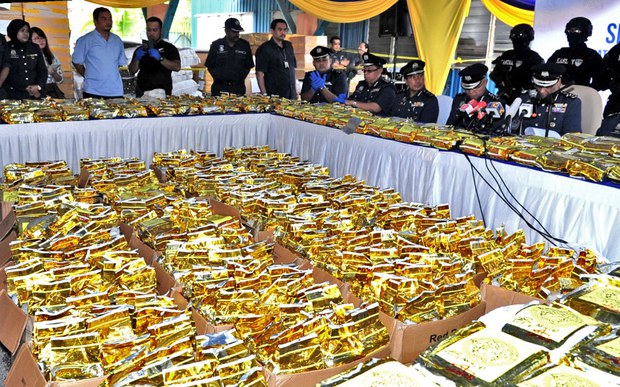Malaysia: Authorities Seize 1,187 Kilos of Methamphetamine Disguised as Food
2018.05.29
Kuala Lumpur
 Packets of methamphetamine valued at U.S. $17.8 million are displayed at the Royal Malaysian Customs office in Negeri Sembilan, May 28, 2018
Packets of methamphetamine valued at U.S. $17.8 million are displayed at the Royal Malaysian Customs office in Negeri Sembilan, May 28, 2018
Updated at 3:10 p.m. ET on 2018-05-29
Malaysian authorities said they seized more than a ton of methamphetamine disguised as food and arrested six people, including a store director, following a raid at a supermarket in Selangor state, south of Kuala Lumpur.
The methamphetamine, broken up into 1,187 packets wrapped in gold paper and each weighing a kilo, was valued at more than 71 million ringgit (U.S. $17.8 million), police said. The size of the haul, which equaled 2,617 pounds, was the largest ever in Malaysia for crystal meth in terms of amount and value, officials said.
The packets apparently were smuggled into the country from Yangon, Myanmar through Port Klang, 27 miles (43.4 km) west of central Kuala Lumpur, according to officials who conducted the raid last week and announced the bust on Monday.
Police also confiscated 750 grams of heroin valued at 120,000 ringgit ($30,000), according to Bernama, the state-run news agency.
Investigators arrested five men between the ages of 22 and 48, Customs Director General Subromaniam Tholasy told reporters.
“The five suspects comprised three from Myanmar and two local men who had just received the container,” Subromaniam said.
After interrogating the suspects, police arrested the supermarket director, a 31-year-old woman, that same day. Those arrested could face the death penalty, if convicted.
In addition, police confiscated more than 1 million cigarettes and 2.5 metric tons of tobacco along with 1.3 metric tons of undeclared medicines.
Investigators believe the drugs were to be distributed in Malaysia.
Drugs are often transported into a targeted area or country through shipments hidden in food cans, exported coffee bags or even food such as pickles and fruits, according to Suhana Ismail and Norhaya Jaafar, both with the narcotics section of the Department of Chemistry Malaysia.
“Very often, the drug products were seized by the authorities but the responsible people for the crime often escape except the packers,” the two said in a report published in the Malaysian Journal of Forensic Sciences in 2015.
Methamphetamine production increases
Last week, as it hosted a regional drug policy conference in Myanmar, the United Nations warned that methamphetamine production and trafficking in Southeast Asia was rising at alarming levels.
Asia’s Mekong region of Cambodia, China, Lao, Myanmar, Thailand and Vietnam was notorious for production of opium and heroin, but has undergone significant transformation in recent years. The U.N. reported that gangs had increased production of low-grade yaba methamphetamine and high purity crystal methamphetamine to “alarming levels.”
“What we’ve seen is steady, year-on-year increases, but on top of that in the last couple years, we’ve seen huge cases – where you see a ton of methamphetamine at a time. And they’re being traced back to the same areas in the north of this country (Myanmar),” said Jeremy Douglas, the U.N. Office on Drugs and Crime’s (UNODC) representative for Southeast Asia, according to CNN.
Meanwhile, despite Malaysia’s tough drug trafficking law, the country remains a transit point for drugs, especially methamphetamine to Brunei Darussalam, New Zealand and Singapore, as reported by UNODC.
Speaking to BenarNews, criminologist Geshina Mat Saat attributed the prevalence of drug trafficking in the region to profit.
“The amount of benefits has been weighed as to being more, compared to the probability and risk of capture,” she said.
Aside from economic factors, Geshina said, Malaysia’s geographical position comes into play in making the country a profitable transit hub for drug traffickers.
“Malaysia also has coastlines with dense mangroves and trees that grow right at the water’s edge making water-to-land transfers difficult to be seen or traced,” she said.







